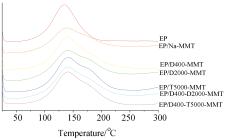1 Wang, D.-Z. Production and Application of Epoxy Resin, Chemical Industry Press of China, Beijing, 2004, p. 4 (in Chinese). (王德中, 环氧树脂生产与应用, 化学工业出版社, 北京,2004, p. 4.)

2 Lan, T.; Pinnavaia, T. J. Chem. Mater. 1994, 6, 2216.

3 Zhang, M.; Zhu, B.; Wang, Q.-F. Fiber Composites 2007,6(2), 21 (in Chinese). (张敏, 朱波, 王启芬, 纤维复合材料, 2007, 6(2), 21.)
4 Teh, S. F.; Liu, T.-X.; Wang, L.; He, C.-B. Composites: Part A 2005, 36, 1167.

5 Ha, E.-H.; Kou, K.-C.; Yan, L.-K., Yan, H.-Y. J. Mater. Sci. Engineer. 2004, 22(4), 568 (in Chinese). (哈恩华, 寇开昌, 颜录科, 颜海燕, 材料科学与工程学 报, 2004, 22(4), 568.)
6 Pinnavaia, T. J.; Beall, G. W. Polymer-clay Nanocomposites, John Wiley & Sons, Ltd, Chichester, UK, 2000.
7 Chiu, C. W.; Chu, C. C.; Cheng, W. T.; Lin, J. J. Eur. Polym. J. 2008, 44, 628.

8 Sahar, G.; Mehrdad, K. Adv. Mater. Res. 2010, 123, 145.

9 Ivan, B.; Jelena, M.; Hrvoje, I.; Marica, I. J. Appl. Polym. Sci. 2007, 3, 1932.
10 Chen, C.-G.; Mohammad, K.; David, C. Prog. Org. Coat.2003, 47, 376.

11 Lin, J. J.; Cheng, I. J.; Chu, C. C. Polym. J. 2003, 35(5),411.

12 Salahuddin, N. A. Polym. Adv. Technol. 2004, 15, 251.

13 Yang, C.; Jiang, X.-L.; Sun, K. Acta Phys.-Chim. Sin. 2005,21(6), 681 (in Chinese). (杨超, 江学良, 孙康, 物理化学学报, 2005, 21(6), 681.)
14 Ngo, T.-D.; Ton-That, M.-T.; Hoa, S. V.; Cole, K. C. Polym. Eng. Sci. 2007, 47, 649.

15 Román, F.; Montserrat, S.; Hutchinson, J. M. J. Therm. Anal. Calorim. 2007, 87, 113.

16 Wang, Y.-Q.; Wang, X.-Q.; Duan, Y.-F.; Liu, Y.-Z.; Du, S.-Y. Clays Clay Miner. 2011, 59, 507.

17 Liu, Y.-Z.; Wang, X.-Q.; Chen, Y.-C.; Du, S.-Y. Acta Chim. Sinica 2012, 70, 911 (in Chinese). (刘羽中, 王小群, 陈贻炽, 杜善义, 化学学报, 2012, 70,911.)















